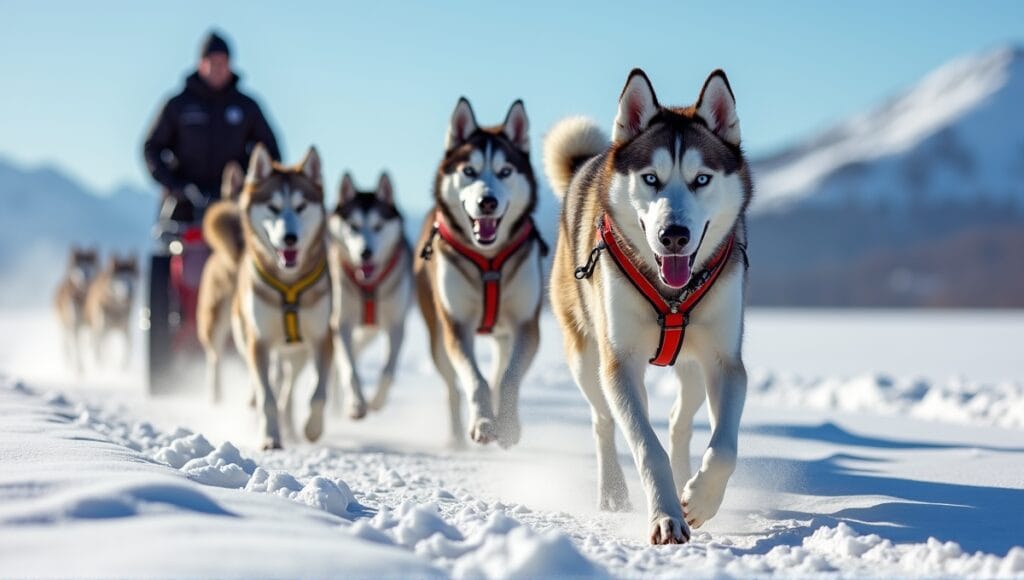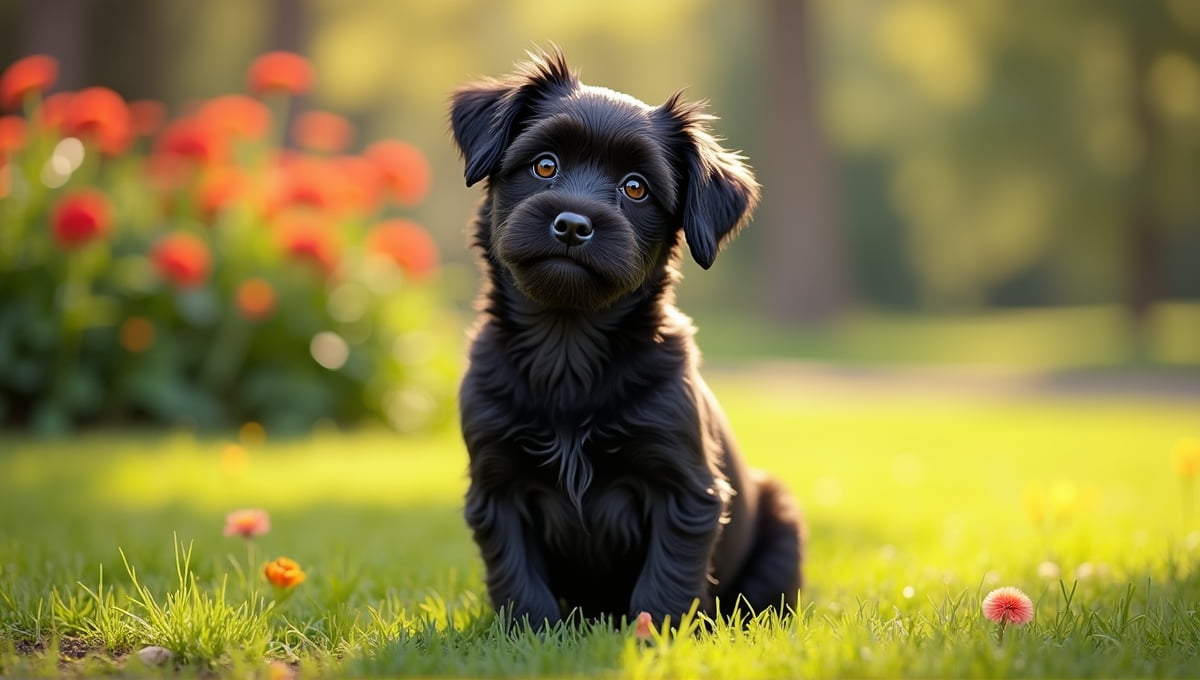Sled dogs are truly phenomenal athletes. I’ve been working with these amazing dogs for years, and I’m always impressed by their strength. In this section, you’ll learn which breeds are best suited to pulling sleds in the harsh Arctic environment. From the famous Siberian Husky to the less common Canadian Eskimo Dog, we’ll cover the best of the best in the world of dog sledding.
Popular Sled Dog Breeds
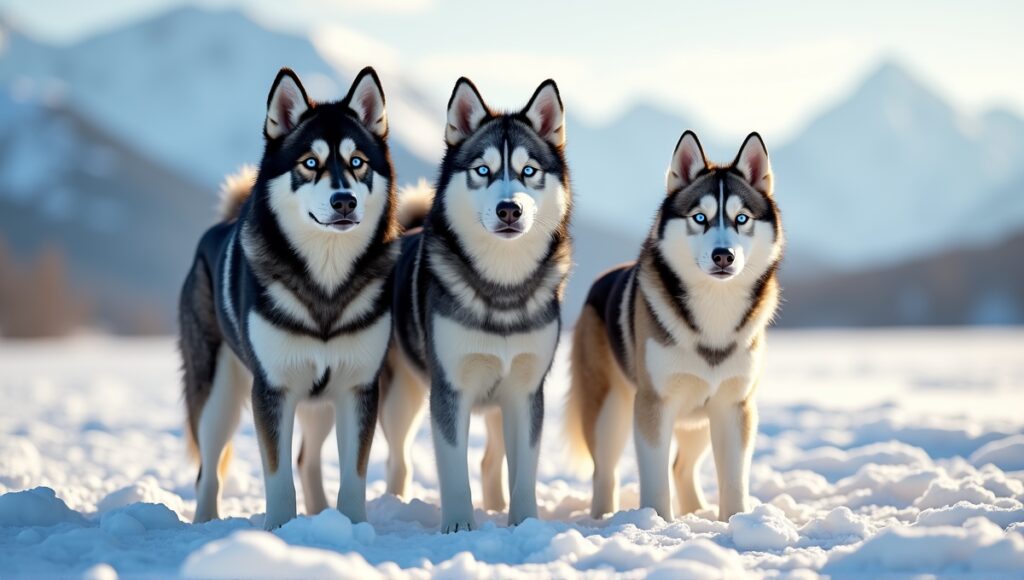
Sled dogs are a remarkable example of the power of the natural world and human ingenuity. I’ve been fortunate to work with sled dogs for many years, and I can tell you these are not your average pooches. Sled dogs are born for power, endurance, and teamwork. Let’s take a look at the most common sled dog breeds you’ll see trekking through snowy landscapes.
Siberian Husky:
- Medium-sized with a dense double coat
- Known for their stunning blue or multi-colored eyes
- Excellent endurance athletes
- Friendly and gregarious
Alaskan Malamute: In the sled dog universe, Malamutes are the heavy lifters. These dogs are larger and stronger than Huskies, and they look similar to a Husky with a more wolfish appearance. Malamutes thrive when pulling heavy loads over a long distance.
Alaskan Husky: While they sound like a Siberian Husky, Alaskan Huskies are actually a mixed breed specifically bred for sledding. These dogs tend to be thinner and faster than a Siberian Husky.
Greenland Dog: These dogs are strong and have been working on the sled for the Inuit people for centuries. They’re known for their impressive cold tolerance and their willingness to work.
Samoyed: You might be familiar with these as popular house pets. However, Samoyeds were originally bred to pull sleds and herd reindeer. They’re strong, intelligent, and surprisingly agile for their size.
Canadian Eskimo Dog: Also known as the Qimmiq, this breed is one of the oldest and rarest sled dog breeds. They’re muscular and have a strong prey drive and cold tolerance.
Each of these breeds has different strengths as a sled dog. Sled dog teams are often made up of various breeds to optimize for a combination of strengths. Some of these breeds, like the Siberian Husky, are also known to be excellent police dog breeds, showcasing their versatility beyond sledding.
Physical Characteristics of Sled Dogs
Sled dogs are not your average dog you keep as a pet at home. They have specific body adaptations for running efficiently and effectively in harsh arctic conditions. So what is it about these dogs that makes them such excellent pullers?
Body build and size: Sled dogs are lean, muscular dogs. They are medium-to-large dogs with a deep chest to accommodate their lungs. Their legs are long and powerful, allowing them to travel long distances.
Coat style and insulation: Their coats must be thick and double layered. The undercoat is soft and dense, which provides insulation. The outer coat is longer and water-resistant, which protects them from the snow and wind.
Paw design specific to snow and ice: Sled dog paws are very tough and compact. They also have fur between their toes, which prevents snow from balling up. In some cases, the breed will even have somewhat webbed feet, which gives them better traction on snow.
Muscle mass for long distances: These dogs will certainly have a high composition of slow twitch muscle fibers. This is what allows them to continue running for hours at a time.
Tail type of a sled dog: Their tails are generally quite thick and furry. When they curl their tail over their back, it acts as additional insulation for their face while they sleep in the snow.
All of these physical features allow a sled dog to continue running for hours at a time in well below freezing temperatures. It’s truly amazing to see them in action. Some of these characteristics are also shared by retriever breeds, particularly their endurance and water-resistant coats.
Historical Background of Sled Dog Breeds
Dog sledding is not a modern activity. It’s deeply rooted in Arctic cultures, and the history of sled dogs is intertwined with human survival in some of the most extreme environments on the planet.
The origins of dog sledding date back thousands of years to when indigenous people in Arctic regions first domesticated dogs for hunting and transportation. As a result, modern sled dogs are a result of evolution from these ancient dog breeds.
The evolution of sled dog breeds occurred through selective breeding. People deliberately bred dogs that were most suited to pulling sleds through snow and ice, and this carefully managed breeding eventually produced the Alaskan Malamute, Siberian Husky, and other sled dog breeds.
The cultural importance in Arctic regions is immeasurable. Sled dogs were essential to the survival of many Arctic peoples, and they used the dogs for transportation, hunting, and companionship. As a result, sled dogs are deeply intertwined in the traditions and stories of Arctic cultures.
Sled dogs played a critical role in early Arctic and Antarctic exploration and transportation. Many early expeditions to the North and South Poles relied on sled dogs to reach their destination and trade routes in northern communities.”
The relationship between humans and sled dogs is the result of thousands of years of collaboration in one of the most extreme environments on earth. This long history of working alongside humans has also made many sled dog breeds excellent candidates as therapy dog breeds, due to their strong bond with people.
Working Capabilities and Endurance
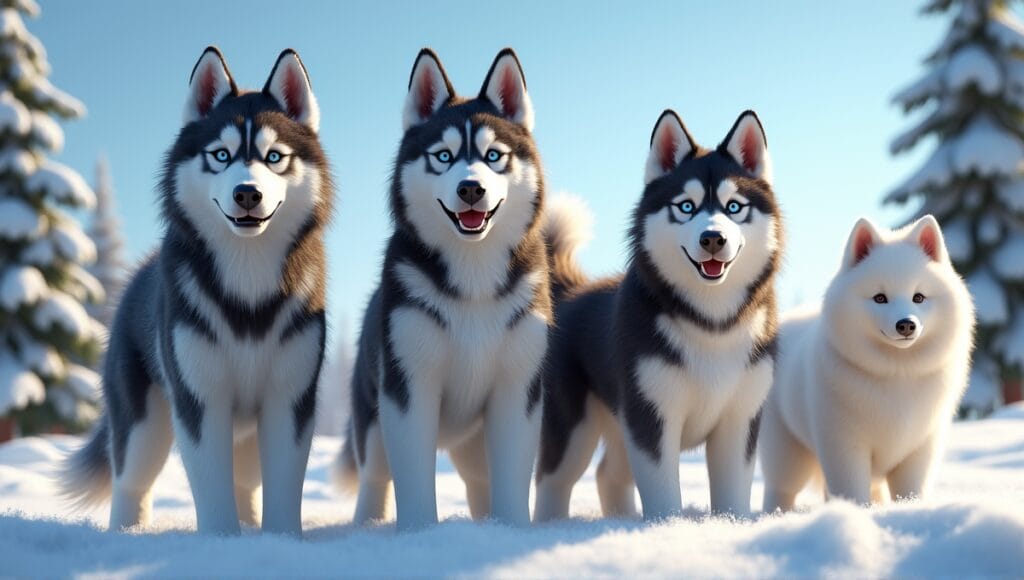
Sled dogs are phenomenal athletes. Their working capacity and endurance is truly impressive. So what makes them such efficient workers?
Distance and speed: _ Can travel as far as 100 miles in a single day _ Maintains an average speed of 10-14 miles per hour over long distances _ Runs at sprint speeds up to 20 miles per hour during short bursts _ Can go for hours in a row at a consistent speed
Caloric needs during peak season are massive. A single working sled dog can burn 10,000 calories a day. For reference, the average pet dog only needs around 2,000 calories per day.
Their heart rate and stamina are also exceptional. Sled dogs have a larger heart relative to their body size compared to other dog breeds, allowing them to pump more blood and oxygen to their muscles during long runs.
Their load-bearing/pulling capacity depends on the breed and size of the team. For example, a team of 6-8 dogs can pull a sled weighing 300-500 pounds. If you have a larger team, they can pull even more weight.
They’re biologically equipped with adaptations to survive in extremely cold temperatures, from their fur to their metabolism.
No other breed of dog can match the endurance of sled dogs. They’re truly the ultimate long-distance runner in the dog world. This incredible stamina and work ethic is also seen in many herding dog breeds, although applied to different tasks.
Temperament and Personality Traits
Working with sled dogs, you’ll quickly realize they have distinct personalities. Their temperament reflects their working history and pack lifestyle.
Common behavioral traits include high energy, strong pack instincts, and a passion for running. These dogs are most content when they have a purpose.
They have a strong pack mentality and pack hierarchy. Sled dogs naturally develop a hierarchy within their team. This hierarchy is important, as it allows them to work together effectively while running.
Most sled dog breeds are highly trainable and intelligent. They pick up things quickly and respond well to training if you’re consistent. However, they can also be independent, which some people mistake for stubbornness.
Most sled dogs get along well with people, although they might be somewhat aloof with strangers. They also have a high prey drive and may not be safe around small animals.
Remember, sled dogs aren’t your typical pet. They need a job and plenty of exercise. While these traits make them less than ideal for many people, they are an exceptionally rewarding pet for those who appreciate these characteristics. For those looking for a more laid-back companion, best companion dogs might be a better fit.
Care Requirements for Sled Dogs
Caring for sled dogs is a significant responsibility, as these working dogs have unique needs different from those of a typical pet. Here’s what to consider:
Nutritional needs:
- High-calorie diet (especially during the working season)
- Balanced combination of proteins, fats, and carbs
- Ensuring they drink enough water
- Supplements to maintain joint health and coat quality
They require a high amount of exercise. Sled dogs need many hours of vigorous activity each day. This isn’t a leisurely stroll around the neighborhood – they need to run and pull to maintain their health and happiness.
Grooming and coat care are essential. Regular brushing keeps shedding under control and ensures their coat stays healthy. Baths aren’t necessary frequently, but check regularly for skin problems.
Common health concerns for working dogs are joint care, foot care, and regular vet checkups. These dogs put in hard work, and their bodies need the right maintenance to continue performing at the highest level.
Offseason care and management should be your top concern. Keeping them physically and mentally satisfied throughout the year is critical to their happiness.
Caring for sled dogs is a full-time gig. But for those who adore these amazing animals, it’s truly a labor of love. If you’re looking for dogs that require less intensive care, you might want to consider low maintenance dog breeds.
Comparison of Sled Dog Breeds
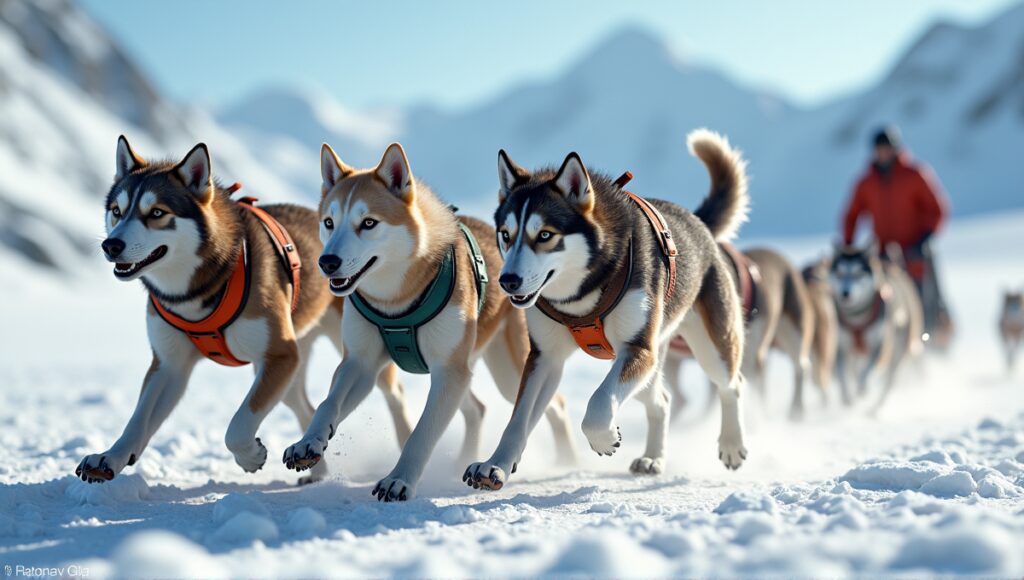
Each sled dog breed has its own strengths and weaknesses. Here’s a comparison of sled dog breeds and their respective strengths and weaknesses:
| Breed | Strengths | Weaknesses |
|---|---|---|
| Siberian Husky | Speed, endurance, pack-friendly | Stubborn, relatively small |
| Alaskan Malamute | Strength, power, cold tolerance | Slow, less speed, more food |
| Alaskan Husky | Versatility, speed, stamina | Inconsistent appearance |
| Greenland Dog | Cold tolerance, endurance, pack size | Aggression, independence |
| Samoyed | Friendly, versatile | High grooming, pack size |
| Canadian Eskimo Dog | Strength, cold tolerance | Rare, high prey drive |
Each breed is also best suited for different sledding purposes. For example, Siberian Huskies and Alaskan Huskies make excellent racers. Malamutes are excellent for heavy freighting. Samoyeds can double as family pets and sled dogs.
They also vary in their ability to adapt to different climates. For example, all of these breeds do well in cold environments, but the Samoyed is a bit more adaptable to warmer climates.
The modern sled dog racing scene favors the Alaskan Husky due to its versatility and speed, as it’s a mix of several different sled dog breeds. However, purebred Siberian Huskies and Alaskan Malamutes are still popular because they have a consistent appearance and good sled dog traits.
Select the breed that has the strengths you’re looking for based on the activity you’ll be using them for and your lifestyle. Each sled dog breed has its own unique strengths, so just do your research and find the breed that has the strengths you’re looking for. If you’re interested in other unique breeds, you might want to explore rare dog breeds as well.
Challenges and Conservation Efforts
There are a few challenges facing sled dog breeds today. Some sled dog breeds are at risk today. The populations of some ancient breeds like the Canadian Eskimo Dog are declining. These dogs are an important part of our cultural heritage, and steps are being taken to preserve them.
The effects of climate change on sledding are notable. With warmer winters, there’s less snow, which impacts traditional sledding territories. This also changes the way these dogs can work.
Preservation and breeding programs are essential. Certain organizations are working to conserve the genetic diversity of these breeds and encourage responsible breeding of sled dog breeds.
There are also some modern applications outside of traditional sledding. Today, sled dogs are used in activities like skijoring, canicross, and even as therapy dogs. These newer applications are excellent ways to keep these breeds relevant.
It’s our responsibility to ensure these incredible, ancient breeds survive. These dogs don’t just offer us a livelihood. They are a living testament to history.
Closing Remarks
Sled dogs are amazing dogs with interesting characteristics and fascinating histories. The breeds range from the well-known Siberian Husky to the less common Canadian Eskimo Dog, and all of them have been essential to Arctic societies and exploration. Their physical attributes, stamina, and pack behavior make them excellent dogs for harsh environments and long sled journeys.
Caring for these highly energetic dogs is challenging, but you won’t find more loyal, hardworking dogs. Climate change is also impacting traditional sled dog races, so it’s important to support conservation efforts to ensure future generations can appreciate these incredible breeds.


